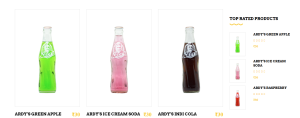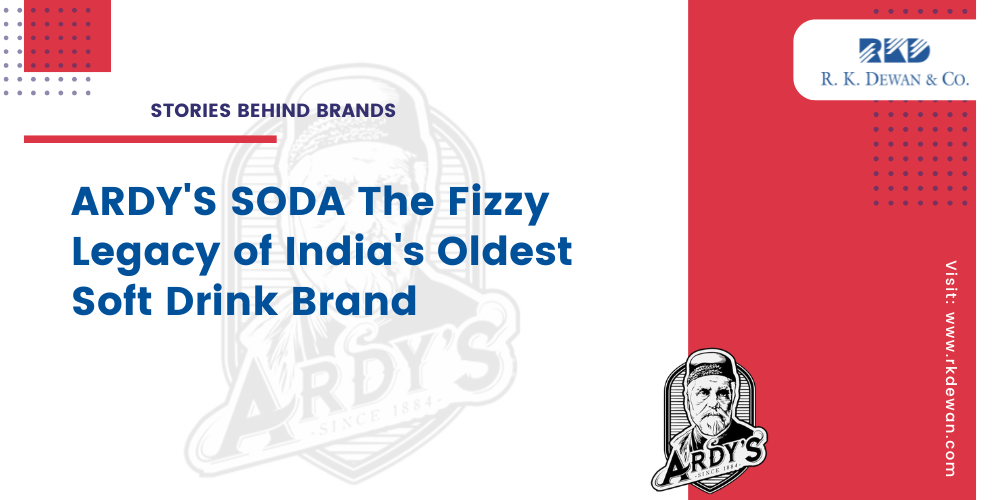Brands are more than just a name or a logo—they are protected trademarks that embody a story and a legacy built over time. Behind every brand, there is a rich history and a unique set of circumstances that have shaped its identity and contributed to its success. These background stories have become an integral part of the brand, and they serve as an essential tool for building brand loyalty and connecting with customers. There are various brands that you think you know about, but do you really know them? In this series of articles, we will be telling you unknown stories behind the known brands.
The Birth of a Beverage Empire (1884)
The late 19th century Pune was a city of contrasts. British colonial officers in their starched uniforms walked past traditional Marathi wadas, while Parsi entrepreneurs established new businesses in this rapidly growing city. It was in this dynamic environment that a young Parsi businessman named Ardeshir Irani noticed something remarkable about British drinking habits.
The British officers stationed in Pune had developed a particular fondness for soda water, which they mixed with their whisky. However, these sodas were expensive imports from Europe, making them inaccessible to most Indians. Ardeshir, with his keen business acumen, saw an opportunity. Why not create an Indian-made soda that could rival these imported brands in quality but be more affordable for local consumers?
In 1884, with limited resources but boundless determination, Ardeshir established his bottling unit in Pune. The early days were challenging. Equipment was basic hand operated bottling machines, manual carbonation processes, and a small team of dedicated workers. Yet, what the operation lacked in sophistication, it made up for in passion and commitment to quality.
The first product was simple but revolutionary for its time: pure, sparkling soda water made with local ingredients. Ardeshir insisted on using only the finest carbonated water, ensuring each bottle had the perfect level of fizz.
The Origin of the Ardy’s Trademark and Brand Identity
The evolution of the brand’s name is as fascinating as the product itself. Ardeshir’s British customers, while appreciative of his soda, found his given name difficult to pronounce consistently. In the convivial atmosphere of Pune’s colonial clubs, where the soda was becoming increasingly popular, they began affectionately referring to it as “Ardy’s soda” – a shortened, anglicized version of Ardeshir.
This nickname, born out of convenience and camaraderie, soon took on a life of its own. Customers would ask specifically for “Ardy’s” when placing orders. Shopkeepers began labeling the crates with the shortened name. By the turn of the century, what began as a casual nickname had become the official brand name, appearing on labels and advertisements.
The name “Ardy’s” perfectly encapsulated the brand’s identity approachable yet distinctive, Indian in origin but with universal appeal. It represented the cultural synthesis that characterized Pune at the time, much like the product itself bridged local tastes with global influences.
As the 20th century dawned, Ardy’s faced its first major challenge. The British soda brands like Schweppes and Bovonto began establishing stronger footholds in the Indian market, backed by colonial trade networks and substantial marketing budgets. These international brands positioned themselves as premium products, appealing to the aspirational desires of India’s elite.
However, Ardeshir Irani understood something his competitors didn’t the importance of local tastes and community connections. While maintaining the high quality that had made his soda popular with British officers, he began adapting his products to suit Indian palates. This strategic insight would become the foundation of Ardy’s enduring success.
The product line expanded thoughtfully. The sweet cola, with its caramel notes and gentle fizz, became a favorite among children and families. The lemonade, perfectly balanced between sweet and tart, became Pune’s go-to refreshment during scorching summers. But the true masterpiece was the masala soda – a bold, complex blend of spices that danced on the tongue, unlike anything else available in the market at the time.
The bottling process itself became a point of pride. Ardy’s distinctive glass bottles, thicker and sturdier than competitors’, were designed to be returned, cleaned, and reused dozens of times. This created not just an environmentally sustainable system (though they wouldn’t have used that term then), but also fostered remarkable customer loyalty. Families would bring back their empty bottles like cherished possessions, knowing they’d be exchanged for fresh, icy-cold replacements.
Ardeshir’s success was not without family drama. His son, Framroze Irani, separated from his father and ventured out to create his own soda brand in the early 20th century—Frams Soda. Named after himself, Framroze’s brand quickly gained popularity, especially for its raspberry soda, which became a sensation in Pune.
Frams Soda was known for its unique, fruity flavors specially its Raspberry soda, setting it apart from Ardy’s traditional offerings. For a time, both brands thrived, with Frams even rivalling Ardy’s in certain markets. However, the competition took its toll.
Despite its initial success, Frams Soda faced significant challenges. The partition of India and subsequent economic changes disrupted supply chains. Additionally, the rise of multinational soda brands in the mid-20th century squeezed smaller players like Frams. Unlike Ardy’s, which had deep-rooted loyalty in Pune, Frams struggled to maintain its foothold.
By the 1970s, Frams Soda had ceased operations, leaving Ardy’s as the sole surviving legacy of the Irani family’s soda empire. The story of Frams remains a bittersweet chapter in Pune’s beverage history a tale of ambition, rivalry, and the harsh realities of business.
The Golden Era (Mid-1900s)
The period from the 1930s through the 1960s marked Ardy’s golden age. As Pune grew into an important educational and cultural center, Ardy’s became woven into the fabric of daily life. The soda was omnipresent – at college canteens, in cinema intermissions, during intercollegiate sports events, and at countless family gatherings.
Irani cafes, those iconic Pune institutions, served Ardy’s alongside their famous bun-maska and chai. The clink of Ardy’s bottles became as much a part of the cafe soundscape as the chatter of students and intellectuals debating the issues of the day. At weddings and religious ceremonies, serving Ardy’s soda became a mark of hospitality and good taste.
Where it had once been the local alternative to British sodas, it now positioned itself as a proud Indian brand with a distinguished heritage. The company emphasized its use of local ingredients and its deep roots in Pune’s community.
The production methods remained remarkably consistent through these years of growth. While competitors began cutting corners with artificial flavors and preservatives, Ardy’s maintained its commitment to natural ingredients. The cane sugar was still carefully sourced, the spices for the masala soda still ground fresh, the carbonation still precisely calibrated. This dedication to quality created fierce brand loyalty – customers might try other sodas, but they always came back to Ardy’s.
Turbulent Times (1970s-1990s)
The latter decades of the 20th century presented Ardy’s with its greatest challenges yet. The liberalization of India’s economy in the 1990s brought an influx of multinational beverage companies. Pepsi and Coca-Cola entered the market with aggressive marketing campaigns and distribution networks that dwarfed anything a regional player like Ardy’s could muster.
Younger consumers, bombarded with flashy advertisements and drawn to the glamorous image of these global brands, began turning away from traditional sodas. Supermarkets and modern retail chains favored products with longer shelf lives and standardized packaging, which often meant favoring the multinational brands over local ones like Ardy’s.
Yet, through these challenging times, Ardy’s maintained a loyal customer base. Older Punekars refused to abandon the taste of their youth. Families continued serving Ardy’s at celebrations out of tradition. Irani cafes kept stocking it as a matter of principle. The brand became, in many ways, a symbol of Pune’s cultural identity – something worth preserving in the face of homogenizing global influences.
The company made strategic adaptations without compromising its core identity. New flavors were introduced – a tangy orange soda, a refreshing pineapple variant – to appeal to younger palates. The packaging was updated while maintaining the iconic glass bottles that customers associated with quality. Distribution networks were strengthened to ensure availability even as modern retail grew.
The Modern Revival (2000s-Present)
The 21st century has seen Ardy’s experience something of a renaissance. Under the leadership of Marzban Irani, Ardeshir’s great-grandson, the company has skilfully balanced tradition with innovation. The original factory still operates in Pune, its thick walls now housing modernized equipment that maintains the same quality standards established over a century ago.
The brand’s visual identity has been thoughtfully updated for contemporary audiences. While the classic logo remains recognizable, its presentation has been refined for modern packaging and digital platforms. Social media presence has allowed Ardy’s to connect with younger consumers, sharing its rich history while staying relevant to today’s tastes.
Perhaps most remarkably, the core product line remains largely unchanged. The Green Apple soda and raspberry that made Ardy’s famous still uses essentially the same recipe developed generations ago. The glass bottles, though now supplemented with other packaging options, continue to be produced and reused much as they were in Ardeshir’s time.

We do not claim any copyright in the above image. The same has been reproduced for academic and representational purposes only.
In an era of constant change and disposable consumer culture, Ardy’s stands as a testament to enduring values. As India’s oldest soft drink brand predating even Coca-Cola’s arrival in the country by decades it represents a living connection to Pune’s commercial and cultural history.
The brand’s significance extends beyond mere nostalgia. In a marketplace increasingly dominated by multinational corporations, Ardy’s demonstrates the viability of local, family-run businesses. Its success proves that quality and authenticity can compete with massive marketing budgets and global supply chains.
For Punekars, Ardy’s is more than just a beverage – it’s a marker of identity. Serving Ardy’s at gatherings is a way of honouring tradition and expressing local pride. The distinctive taste of an Ardy’s masala soda or the crispness of its original soda water evokes memories and emotions that global brands simply cannot replicate.
The company’s commitment to sustainable practices, from its returnable glass bottles to its local sourcing, resonates with contemporary environmental concerns in ways that feel almost prescient. What began as practical business decisions a century ago now positions Ardy’s as a pioneer of circular economy principles.
With 79+ years of IP excellence, R K Dewan & Co. is a trusted trademark law firm in India, serving 5000+ Indian and international clients. We offer complete trademark solutions—search, filing, prosecution, and enforcement—with strong expertise in trademark infringement cases and brand protection.
From startups to global brands, we help businesses secure and defend their trademarks across India and over 125 countries. Our team specializes in resolving trademark disputes, managing portfolios, and filing under the Madrid Protocol.
Protect your brand with expert legal support from RKD.


